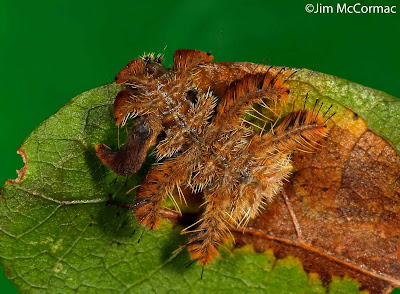In the last post, I briefly described our inaugural trial run caterpillar workshop that was an offshoot of Mothapalooza. More importantly, I shared lots of cool caterpillar photos. I will continue in the latter vein in this post.
This big bruiser is an Imperial Moth caterpillar, Eacles imperialis. As one might expect from such a sizeable cat, the moth that it morphs into is also huge - bat-sized. Most of the last or later instar caterpillars that I've seen have been this showy shade of lime-green. But they certainly can vary in hue. Read on...
This cinnamon-colored beast is also an Imperial cat! Wow! We found this one about two weeks ago at Buzzard's Roost Preserve in Ross County. It was near another that looked identical. First time I'd such a wild color variant, but they are well known for sporting different coats.
Here we have one of Nature's most superb mimics, a Juniper-twig Geometer caterpillar, Patalene olyzonaria. It feeds on Red Cedar, Juniperus virginiana (obviously), and has evolved a look that renders it nearly undetectable. A living needle, if you will. When I found it, it was dangling below a branch on a silken belay line, or I'd never have seen it. I'd bet Prairie Warblers find plenty, though - they are habitual foragers in cedar trees.
There are a number of species that artfully duplicate the look of leaves dappled with necrotic patches of brown tissue. This is one, the Lace-capped Caterpillar, Oligocentria lignicolor. Even though it is a fairly large caterpillar, it's quite easy to pass one by, even at close range.
The weird Monkey Slug, Phobetron pithecium, always a major crowd-pleaser. One theory has it that this caterpillar mimics the appearance of a shed tarantula skin. No, we don't have tarantulas here, but this group of moths is a largely tropical lineage and many of the neotropical migrant birds that might encounter a Monkey Slug winter in tropical regions that harbor tarantulas. Note how the cat picked a brown patch of leaf to secrete itself on, and it blends remarkably well.
A Nason's Slug, Natada nasoni. The little slug moth caterpillars are always pleasing, and people who have never encountered one are usually excited by them. Most slugs are tiny and one must keep a close eye on the leaves - especially the undersurfaces - to spot them. Note the intricate patterning of pale stripes, and the jewel-like fascicles of scarlet setae.
If this looks like an ugly glop of bird excretia, the caterpillar would be happy that it fooled you. Many species of caterpillars (and other animals) are excellent bird dropping mimics. Apparently very little to nothing wants to eat bird poo. When Laura Hughes spotted this one, it temporarily mystified us, then lit the group up with excitement. It's a Paddle Caterpillar, Acronicta funeralis, one of the true Holy Grails of caterpillar hunters. It's only the third one that I've seen. If it makes it, it will morph into a Funerary Dagger Moth.
Amazement never ceases. We had the Paddle Caterpillar in captivity overnight, and by the next morning it had molted into its final instar! Hardly looks like the same animal. The paddles are much more developed, and it looks like little clam shells adorn its back. I suspect it uses those paddle-tipped setae to swat away parasitoid flies and wasps.
Many of the caterpillars that we found were victims of parasitoids, either flies or wasps. Such predation is exceedingly common. Indeed, nearly all of the Skiff Moth slugs that we found had tachinid fly eggs attached. This one is a Yellow-shouldered Slug, Lithacodes fasciola, and it has received a double whammy. Nine or ten braconid wasp grubs have just popped from its skin, and are forming shroudlike silken cocoons around their bodies. There are also at least four tachinid fly egg cases on the caterpillar - the ovoid ivory bumps.
Parasitoids are different than parasites in that they generally kill their host. Shortly after an egg is deposited on the victim, the grub hatches and bores inside the host. It eats the innards until it matures, then does what we see here. In relatively short order, the wasps will pop from the cocoons.
Gruesome as this may seem, such predation is absolutely vital to keep the stocks of other insects in check. The intricacies of the food web at work, just not in a particularly Disneyesque way.
I told you slug caterpillars are beautiful! This one is a Red-crossed Button Slug, Tortricidia pallida.
A personal favorite, the striking Red-humped Caterpillar, Schizura concinna. As is the case with many moths, the caterpillar is far more striking than the moth it will (may) become.
A congregation of Red-humped Oakworms, Symmerista concinna, under an oak leaf. At least in its earlier instars, this species clusters in groups on the underside of a leaf during the day.
For some reason, I really find this caterpillar quite artistic and spent much time making photos of it. Thanks to Diane Brooks, caterpillar rancher extraordinaire, for bringing along some of these Scallop Moth caterpillars, Cepphis armataria. I had never seen this species, and was struck by their style of dangling upside down from a stem in a J-shape with a flourish. From any distance, it would be quite easy to dismiss the cat as a bit of dead plant debris.
I've got one more batch of really cool cat pics to share sometime in the near future.













1 comment:
Can't wait to see them.
Post a Comment